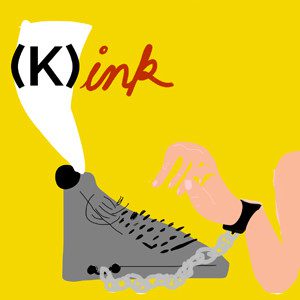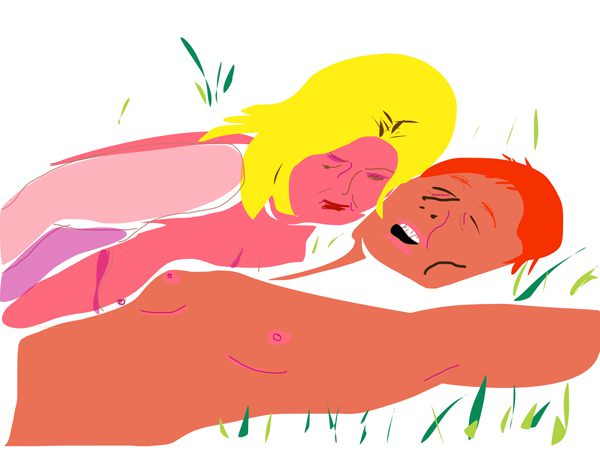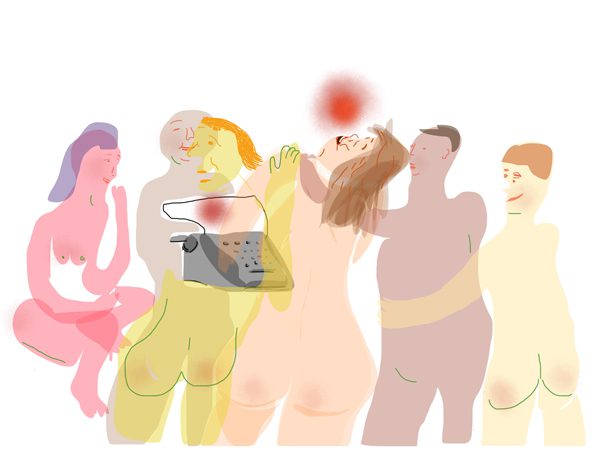
There’s evidence that D.H. Lawrence enjoyed an erotic power exchange relationship with his wife, that James Joyce was into scat (among other things), and that Oscar Wilde—well, most of us know what Oscar Wilde liked. These literary geniuses explored radical sexual agency and desire in their work and in their relationships, but little beyond rumors and personal letters exist to tell us what they themselves thought of their turn-ons and the ways in which those dovetailed with their writing. Even if space for such a discourse and community had existed back then, Lawrence, Joyce and Wilde couldn’t freely discuss their sexuality. As it was, they faced censorship and generated scandal wherever they went, and of course Wilde went to prison for his sexual behavior.
Although our world is still intolerant of sexual difference, I want to believe we’re at a point where people can speak openly about the consensual ways we express our erotic selves. And I’m interested in the connections between those private expressions and the larger, more public work we do in the world. This series is meant as a forging of community; a validation of that which gets called sexual deviance; and a proud celebration of the complex, fascinating ways that humans experience desire.
In this ongoing series of short personal essays, writers in all genres—novelists, poets, journalists, and more—explore the intersection between our literary lives and practices and our BDSM and fetishistic lives and practices. In other words, these essays aren’t about writing about non-normative sex: rather, it’s a series about how looking at the world through the lens of an alternative sexual orientation influences the modes and strategies with which one approaches one’s creative work.
If you have questions or comments, or if you’re a writer who would like to contribute, please contact me at kinkwriting@gmail.com.
–Arielle Greenberg, Series Editor
***
Cunts & Catastrophes: Trauma Play and Writing
Last June, Feminist Press made an English-translated and unabridged reprint of Violette Leduc’s Thérèse and Isabelle available in the US for the first time. I had been waiting for this particular banned book to appear in circulation. Shameless disclosure: I own a VHS copy of the sexploitation film adaptation of Thérèse and Isabelle, a wannabe art house production that Roger Ebert pronounced the worst movie of 1968. And it’s not just this film I love: I can easily waste a day binge-watching grindhouse hits directed by Radley Metzger, Russ Meyer, and Doris Wishman. While many cult followers laud the nonsensical narration and low-production aesthetics that hallmark the sexploitation genre, I look specifically for arousing variations on a theme that I’ll call Cunts & Catastrophe—or Muffs & Malcontent, Boobs & Burdens, Tits & Torment (add to this alliterated list as you like). So when I read Thérèse and Isabelle in one sitting, it was not to observe a nearly lost text from the lesbian canon. I was just greedy for more Cunts & Catastrophe.
 Consistent with just about every other teenage lesbian narrative, Thérèse and Isabelle’s secret affair suffers the threat of being exposed, though the crux of their suffering comes from aggrandized insecure-attachment behaviors. Again and again, they fail to make eye contact that is intense enough, to vocalize their desires persuasively enough, or to hold each other forcefully enough: “We squeezed each other until we nearly suffocated. Our hands shaking… our arms fell back, our inadequacy astonished us… ‘Harder harder, squeeze,’ she demanded… ‘don’t you know how?’”
Consistent with just about every other teenage lesbian narrative, Thérèse and Isabelle’s secret affair suffers the threat of being exposed, though the crux of their suffering comes from aggrandized insecure-attachment behaviors. Again and again, they fail to make eye contact that is intense enough, to vocalize their desires persuasively enough, or to hold each other forcefully enough: “We squeezed each other until we nearly suffocated. Our hands shaking… our arms fell back, our inadequacy astonished us… ‘Harder harder, squeeze,’ she demanded… ‘don’t you know how?’”
This doomed symbiosis titillates me, and feels rather familiar. More familiar still is a passage found on page thirty-seven where, during the close of a love scene, Thérèse begins to talk about her mother. A hostile mother with appallingly unhealthy boundaries, a mother character who closely resembles Leduc’s own childhood abuser, whom Leduc wrote unflinchingly about in her only well-received book, her memoir La Bâtarde.
La Bâtarde, published in 1964, was shortlisted for the Prix Goncourt, a prize nomination that ought to have earned her esteem. Two years later Thérèse and Isabelle was banned. Censorship and controversy have battered much of Leduc’s fiction, with critics targeting explicit lesbian sex and themes of incest and familial abuse. I wonder if Leduc was ever admonished for writing her abusive mother into love scenes? Was the reoccurrence of trauma, which readers applauded in her memoir, the reason why her subsequent books were censored or banned? While other queer text had been celebrated in France the 1950s and 1960s, why was Leduc deemed unfit for readers?
Page thirty-seven is where my own reading experience shifted from subjective pleasure to somatic. I too feel the presence of my mother when I’m with a lover. In truth, the mere proposition of sex can conjure my mother—or all the abusers, including those who failed to protect me. I am a survivor of multiple perpetrator sexual abuse. I possess and am possessed by traumatic memories, which were established in early childhood and prevailed well into my twenties when I was a street-based sex worker. Cunts & Catastrophe describes how I view my sexuality to a greater degree than any of the appellations regularly found in my author bio. Like Leduc’s protagonists, I struggle with insatiable sexual neediness juxtaposed with an almost absurd inability to receive, my associative mind has been conditioned to link arousal and danger, and I’m a topnotch catastrophizer.
During my teen years, I not only earned a reputation as the small town slut, but the small town slut who cried while performing blowjobs. My first serious boyfriend blamed our breakup on my tendency to become “catatonic” during sex. The discovery of queer sex reduced the amount of stigma I felt as a promiscuous survivor, though the sex-positive queer feminist messages of the 1990s (my coming out years) offered uncertainty as well as assurance. I was proving too distant, too boundaried, or too sullen compared to my subversion-worshiping cohort. What if I was never a mindful, empowered, and fully present lover, as sex-positivism encouraged? The 90s were also my party years, so as expected, I drank my way (or GHBed or MDMAed my way) into wild and detached sex. I also put many hours into therapy. I completed The Courage to Heal cover to cover. I gave transcendental meditation a shot.
Nowadays, I might adopt a stone femme identity, which spares me the physiological and cognitive symptoms of shame (like nausea or self-blame) that frequently follow orgasm; I then feel a deep grief for the cunt I refuse to let out of my pants. Other times, I spread my legs and welcome tops to fist me, all the while reciting an inner monologue of “don’t think about being molested, don’t think about being molested.” All of these therapeutic practices and coping—or being—mechanisms are perfectly apt, yet none expunge the past from the present. No matter how I have tried to rectify this, the abuse is always there.
You want to know what helps? Rape Fantasies. Coerced Rough Sex Play. Trauma Play.
Trauma Play helps! Exclamation point.
Presently, I can Google search Trauma Play and, on the first hit, find kink-aware therapist Dr. Joe Kort’s blog post “Shades of Play: Trauma Reenactment Versus Trauma Play” on Psychology Today.
In the 90s, however, psychotherapists didn’t blog. Besides, anything kinky was still listed as a disorder in the Diagnostic and Statistical Manual of Mental Disorders. I discovered Trauma Play like any pre-new-media age queerio would: through an older, hard-knocks, leatherdyke lover. This lover introduced the idea that kink can be used to teach the nervous system to respond differently to triggers, to literally rewire the brain to make positive new associations with arousal and with pain. “You can’t get the demons out of your head,” I remember her saying as she knocked her tattooed knuckles on her forehead. “So why not bring the demons into the bedroom?”
Carefully we negotiated a scene: I wore a flannel nightie. I drank a faux-dosed mug of warm milk and slipped into faux-sedation. My much larger lover’s body weight “nearly suffocated” (quoting Leduc) me as I assumed the role of a child-sized victim. She roughly fucked me on a shag carpet while The Tonight Show with Johnny Carson played in the background. The scene ended with her smearing hot lube and stage blood between my thighs, then leaving me to wake up alone and soiled to the monotone sound of NBC broadcast sign off signal.
Except I wasn’t alone. Minutes later, as my lover and I debriefed, I realized the true power of the scene—the co-existence of the traumatized body (and the reactions and anxiety attached to her) and the cognizance of a judicious adult self, the self who has the agency to debrief, to break the silence. Aha moment. Past and present needn’t be at odds with each other after all.
This insight crystalized as I gradually sought out other survivors at play parties and kink conferences, and joined kinky survivor groups that gather online. Locating myself within these communities gifted me far more than a validation for wanting Trauma Play. I now have a well-established common credo to lean on: trauma and healing can be positively assimilated and very much revered within sex and play. I consistently witness leather folk celebrate this credo, not just individually, but cooperatively. I’ve put on my leathers and gone to play parties solely to contribute to survivor aftercare circles: to hold space where our pasts are acknowledged and our present day desires are revered.
I’ve always viewed my writing process as a kin to Trauma Play. It too is a rough, penetrative reenactment with as much temporal particularity as the page can handle. The Tonight Show was critical to the authenticity of the abovementioned scene. If I were to write the same memory as a personal narrative, I would likewise need to invoke sensory experience. The reader should be able to hear Ed McMahon’s drawn-out “eee” in “Here’s Johnny,” followed by that optimistic jazz trumpet.
And I know I’ve written something of consequence when my body gets involved: muscle spasms, crying, cumming. Not writing about cumming: not an energy orgasm or “thinking off,” as sexologist and educator Barbara Carrellas ecstatically champions. I’m talking about my pussy drooling through my clothes and onto my office chair as I’m ticking away at the keyboard. (I’ll save the tutorial on non-touch simulation genital orgasm for another essay.)
Immersive as the writing process is, I can always safe-word or renegotiate. I am aware of my limits and no-go subject matter in my writing, just as I’m aware of my no-go activities in kink. The more I approach my writing process as a form of kink, the more I produce.
Yet my second book How Poetry Saved My Life: A Hustler’s Memoir took me a decade to write. I began the book as an undergrad and continued through my MFA in Creative Writing. Members of my cohort told me my writing was “overly personal,” though it was no more or less personal than any other personal narratives submitted to the workshop. One professor cautioned me not to confuse therapeutic writing with literary writing, though students with lighter subject matter yet less crafted writing did not receive the same warning. Another professor requested we take a break because my content was giving him nightmares. At least he was forthcoming about his bias.
Outside of the institution my work fared no better. Upon reading an early draft of my memoir, a mentor and a friend asked me if I considered myself a “victim-type” writer. His own writing is hallmarked by violent content, so I redirected his question back at him. “Writing about victims and being a victim are two different things,” he replied. I discontinued my friendship with him.
The first publisher to look at my manuscript was interested, but only if I downplayed the queer narrative, removing my wife as a “character” altogether, and expanded the sections of the book where I wrote about being a street-based and highly vulnerable sex worker, and also the sections where I later exited the trade. The publisher wanted a whore’s redemption story.
But the most discouraging warnings came from other sex workers. They advised me never to write about childhood sexual abuse, as I would only be re-enforcing the dangerous stereotype that sex workers are all suffering from post-traumatic stress.
To this day I still wonder how much of those ten years of memoir writing were spent grappling with messages about how my own story should or should not appear on the page. I likewise wonder what messages were hurled at Violette Leduc by her publisher and peers. We know her publishing house withheld Thérèse and Isabelle in 1954, and that Leduc disclosed contemplating suicide while waiting to find out if her book would be released or banned. We also know that Leduc isn’t a unique example. All my favorite authors combine themes of trauma with themes of queer and/or trangressive sexuality, and all have faced backlash. One of Sapphire’s earliest poetry publications, “Wild Thing” printed in a journal funded by the National Endowment for the Arts, was circulated among Congress by then-Senator Jesse Helms as an example of “filth and blasphemy.” Sapphire went on to publish two poetry collections that bridged trauma and sexuality—American Dreams and Black Wings & Blind Angels: Poems—and her novel Push. In Dorothy Allison’s memoir Two or Three Things I Know for Sure, the author addresses messages she’d received writing concurrently about trauma and sex: “sex and violence, love and hatred. I’m not ever supposed to put together the two haves of my life—the man who walked across my childhood and the life I have made for myself… [as a] lesbian, dyke… and perversely lustful.”
It’s both unthinkable and sadly predictable that countless authors face such backlash or marginalization. These particular books have gifted me words to survive by: I returned to the pages of Black Wings & Blind Angels: Poems many times as I wrote my memoir. It is one of my antidotes to the victim-blaming that attempts to diminish my work. My memoir is subject to the same type of victim-blaming that I myself face as a survivor. It was, in fact, easier to find a queer kinky community that held hallowed space for my trauma at play parties than it was to find a writers’ community that was comfortable with my more graphic content. I am, in fact, still searching for this very writers’ community.
What do we as writers tell each other about the intersections of trauma and desire? How do we encourage (or discourage) each other to reveal the power and tensions in those margins?
 Maybe if the literary world was run by kinky folk, we wouldn’t see texts that explore trauma relegated to literary silos or censored, and we wouldn’t witness authors of these texts face backlash or stigma.
Maybe if the literary world was run by kinky folk, we wouldn’t see texts that explore trauma relegated to literary silos or censored, and we wouldn’t witness authors of these texts face backlash or stigma.
If there is one absolute lesson kink has taught me, it’s that what happens after the scene is as important as the scene itself. I reclaimed pleasure through Trauma Play, but it is aftercare and belonging to kinky survivor communities that has healed me. If the writing process can be likened to kink, why can’t the consulting, editing, and publishing be like really good and nurturing aftercare? Where are the writers’ groups that debrief writing about trauma and desire? Where are the spaces where writers’ reteach our nervous systems to associate writing about trauma with dignity? I want to role-play the shit out of a couple dreadful book reviews I want to launch my next book to a chorus of You’re such a brave, good girl. I see you, femme. I see you.
I would not be half the brazen, trauma-busting pervert I am today if I hadn’t found my people. But can I create the kind of survivor reverence found in kink space within my own writing and within my writing communities? These are questions I’ll likely be turning over for a long time. Catastrophe means to overturn, to reverse course, from the Greek katá (over) stréphō (I turn). Cunts & Catastrophe is my sexuality. If it’s your sexuality too, I suggest we find each other. I suggest we create the reverence we deserve.
***
Rumpus original logo and art by Liam Golden.




